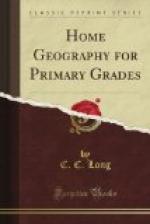What does it mean when the bluebird comes
And builds its nest, singing
sweet and clear?
When violets peep among blades of grass?—
These are the signs that spring
is here.
What does it mean when berries are ripe?
When butterflies flit, and
honeybees hum?
When cattle stand under the shady trees?—
These are the signs that summer
has come.
What does it mean when the crickets chirp,
And away to the south the
robins steer?
When apples are falling, and leaves grow
brown?—
These are the signs that autumn
is here
What does it mean when days are short?
When leaves are gone, and
brooks are dumb
When fields are white with drifted snow?—
These are the signs that winter
has come.
LESSON XLI.
THINGS FOUND IN THE EARTH.
The earth contains many things that are of great value to us. These we must find and dig out.
The coal we burn in our grates to warm us; iron, from which so many useful things are made; gold, silver, tin, lead, and copper,—all come out of the earth.
But these are not all the valuable things hidden away in the earth.
From salt wells we get a great deal of the salt used on our tables. From oil wells is obtained the oil we use in our lamps to give us light. Diamonds which sparkle so beautifully, and the stone we use in building, are also taken from the earth.
Coal, iron, gold, silver, lead, tin, copper, mercury, and salt are called minerals.
The opening dug in the earth from which minerals, except stone, are taken; is called a mine.
One of the most useful of minerals is coal. Did you ever stop to think how much hard work coal does for us? It grinds our wheat, it weaves our cloth, it carries us by sea and by land over the earth. Hardly any labor can be done without coal.
[Illustration: OIL WELLS.]
You have noticed that some coal burns with a great deal of flame and smoke. That is called soft or bituminous coal. That hard, clean-looking coal, which burns with little blaze, yet gives out such great heat, is anthracite coal.
Coal has many uses. Mention all you can think of. From which kind is gas obtained, hard or soft coal?
What is coal? Some day you will be able to understand how coal was made, and how it got deep down in the earth.
What article used with food is found in mines? Does all salt come out of the mines? How is the salt made that is not found in mines?
There are salt mines where men, women, and children live all their lives, and never see sun or sky. Many great rooms and galleries, with tall pillars to hold up the roof, are cut out of the salt. When lighted up with torches, they glitter as if studded with precious stones. It is like a fairy palace.




